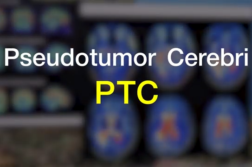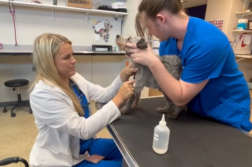St. LOUIS, Mo. (Ivanhoe Newswire) — Glioblastoma is the most common form of brain cancer and also the most deadly. Surgery, radiation and chemotherapy can buy patients precious time, but in most cases, it’s no cure. Now, researchers have found a high-tech laser surgery that may have an added benefit for patients.
Thirty-nine-year old Campbell Laird loves every minute of family game night with wife Martha and their three kids. Just three years ago, Laird was running out of chances.
“I trembled a lot,” Laird told Ivanhoe.
Laird’s tremors were caused by an aggressive form of brain cancer. Doctors recommended a high-tech laser surgery.
Eric Leuthardt, MD, a neurosurgeon at Washington University School of Medicine in St. Louis described the procedure, “It’s a small incision, probably about the length of my fingernail, in the scalp. A small hole in the skull about the size of a pencil and then this laser probe gets placed into the center of the tumor.”
The heat zaps cancer cells. But Dr. Leuthardt has also found an unusual benefit to the laser surgery. Researchers say the lasers break down the brain’s natural barrier designed to keep toxins out.
“By breaking down the blood brain barrier, we now have a window to give new type of therapies that would otherwise not get there,” Dr. Leuthardt told Ivanhoe.
Researchers say the laser keeps the barrier open for four to six weeks after the surgery, allowing time for chemo drugs to work. For Laird, the treatment has restored his movement. Three years ago, he could barely hold a pencil, now he’s sketching cartoons for his kids.
Laird said, “I think this laser ablation thing is a really good option for people.”
“He’s got no evidence at this time of a recurrence,” detailed Dr. Leuthardt.
Researchers studied 14 patients with glioblastoma. The FDA approved the laser surgery in 2009, but researchers say this is the first time the laser has been shown to allow the drugs to penetrate the brain. Studies are ongoing to see if this will make a difference in patients’ survival.
Contributors to this news report include: Cyndy McGrath, Supervising and Field Producer; Milvionne Chery, Assistant Producer; Tony D’Astoli, Editor; Brent Sucher, Videographer.
MEDICAL BREAKTHROUGHS
RESEARCH SUMMARY
TOPIC: Fighting Brain Cancer with Lasers
REPORT: MB #4147
BACKGROUND: Glioblastomas Multiforme (GBM) are malignant tumors that arise from astrocytes; these are the star-shaped cells that make up the “glue- like” supportive tissue of the brain. These cancers are highly malignant and are known to be the most invasive type of tumor because they grow rapidly and can also spread to nearby brain tissue. This form of cancer is devastating and deadly because it typically results in death the first 15 months after diagnosis. GBM’s are very aggressive tumors which make treatment very difficult due to the following characteristics: 1) localization of tumors in the brain, 2) limited capacity of the brain to repair itself, 3) migration of malignant cells into adjacent brain tissue, 4) a limited response to therapy, 5) inherent resistant to conventional therapy, 6) tumor capillary leakage which results in an accumulation of fluid around the tumor, and 7) the variably disrupted tumor blood supply which inhibits effective drug delivery. (Source:http://www.aans.org/patient%20information/conditions%20and%20treatments/glioblastoma%20multiforme.aspx)
SYMPTOMS: Symptoms for patients with glioblastoma vary depending on the location of the brain tumor. These symptoms include:
-Persistent headaches
-Blurred vision
-Vomiting
-Loss of appetite
-changes in mood or personality
-changes in ability to think and learn
-new onset of seizures
-speech difficulty of gradual onset
(Source: http://www.abta.org/brain-tumor-information/types-of-tumors/glioblastoma.html )
TREATMENT: There are several options when it comes to treating a patient with glioblastoma. But whatever the form of treatment may be, it needs to be done quickly and efficiently because the tumor is so malignant and could rapidly spread to other parts of the brain. The most common forms of treatment for GBM’s are surgery, followed by radiation and chemotherapy. During surgery, the doctor aims to remove as much of the tumor as possible without injuring any surrounding parts of brain that may be needed for normal neurological functions. Surgery provides the ability to reduce the amount of tumor tissue within the brain which can actually prolong the lives of certain patients, or improve the quality of the affected patient’s remaining life. Once the surgery is complete, radiation therapy can begin which aims to selectively kill the remaining tumor cells that have managed to infiltrate the surrounding normal brain tissue. The use of radiation therapy provides most patients with longer survival rates and improved outcomes. The current standard of treatment for GBM is chemotherapy which lasts six to twelve cycles. Though surgery, radiation and chemotherapy are beneficial in certain aspects, they won’t necessarily get completely rid of the tumor. For this reason, researchers are always searching for new treatments when it comes to glioblastoma because the most effective treatment methods have only improved survival rates by three months.
FOR MORE INFORMATION ON THIS REPORT, PLEASE CONTACT:
Judy Martin
Public Relations
314-286-0105
If this story or any other Ivanhoe story has impacted your life or prompted you or someone you know to seek or change treatments, please let us know by contacting Marjorie Bekaert Thomas at mthomas@ivanhoe.com




